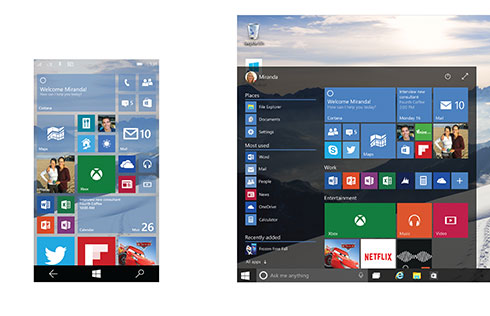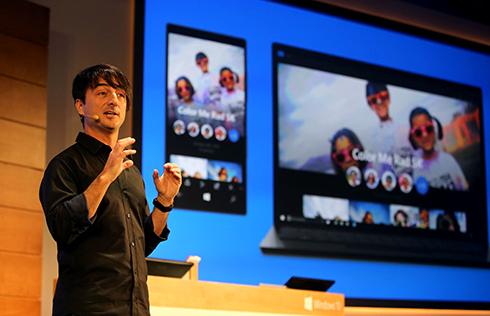Microsoft goes for broke with Windows 10

Microsoft is thinking big with Windows 10: Source: Microsoft
Microsoft's latest presentation on Windows 10 has been a revelation, not just for all the bells and whistles the software giant had on offer, but the fact that it has managed to turn a routine Windows software upgrade event into a media spectacle.
The HoloLens and its grand visions of holograms and augmented reality may have something to do with that, but there are also some signs of improvement across the board here from Microsoft.
The company has never been short of ambition but with Windows 10 its CEO Satya Nadella just might be hoping to exorcise the ghosts of everything Microsoft has done after Windows XP.
The software giant has had its struggles in reconciling its PC-centric side with the mobile world and Windows 10 is its best attempt yet to unify the two worlds, a world where the device type doesn't matter, only Windows does.
It's a reset of sorts for Windows and has important implications for the enterprise market. But it might not be enough to resuscitate Microsoft's mobile ambitions.
Here's what Microsoft is promising with Windows 10, we'll get to the HoloLens in due time.
Windows 10 for all

One OS to rule them all: Source: Microsoft
With Windows 10, Microsoft envisions a common operating system and an application platform for all device types – PCs, smartphones, tablets and even the Internet-of-Things (IoT) devices.
The big plus is here is the consistency that it brings to the table, something that developers will certainly welcome and presumably, also appreciated by users and IT teams.
When it comes to apps, Microsoft is pushing them to run across all platforms. Universal apps are designed to run on all Windows 10 devices and the magic word is adaptability. Apps built on one integrated development environment can be designed to deliver a consistent experience, adapt to a wide range of use cases and sold through one combined app store. Using the same operating system across the board isn't a bad idea, provided the UI (user interface) is up to scratch.
That's the challenge that Microsoft is hoping to tackle with Windows 10.
Mobile traction still out of reach
Microsoft doesn't have the best track record when it comes to mobile apps, so this strategy could be a good way for Microsoft to breathe some new life into its app ecosystem, which at some point should have a flow on effect on its mobile ambitions.
But getting traction in mobile is still going to be a struggle for Microsoft and analysts at Forrester Research contend that Windows 10 won't be enough.
Microsoft faces a long road ahead to gain Windows share in mobile. According to IDC, in Q3, 2014 Windows Phone had 2.9 per cent market share. In comparison, Android had over 80 per cent market share while Apple's iOS was little above 11 per cent.
The numbers aren't pretty and unlikely to get better in a hurry, according to Forrester.
While Windows 10 should make a reasonable impact in the enterprise space, its appeal is still likely to be limited.
“Consumers will be much harder to win for Windows tablets and smartphones, which will limit the value for enterprise in a world driven by consumer adoption trends,” Forrester said.
“While the new unified development model allows developers to more easily deliver universal Windows applications that work on mobile devices, it doesn't give them an advantage on what makes mobile apps special: delivering on mobile moments.”
So not the best prognosis when it comes to mobile, and with regards to Windows Phone there wasn't a lot from Microsoft on that front at the presentation. With Windows 10 destined to be the one operating system to rule them all, the Windows Phone brand is most likely finished.
Resuscitate the upgrade cycle

Free upgrades but will it be enough?: Source: Microsoft
Offering Windows 10 upgrades to current Windows 7 and Windows 8 users for free is really a no-brainer from Microsoft. Windows upgrade licenses currently start at $119.99 and getting enterprises and consumers to upgrade from Windows 7 is a key priority for Microsoft ,
Windows 8 has been installed on more than 100 million PCs, according to Microsoft, but that's just scratching the surface given the 1.5 billion PCs in use.
The inability to get users to migrate to every new variant of Windows has been a challenge and according to Forrester, left developers and IT teams facing a fractured installed base of Windows 7 PCs, with a mix of Windows 8 and badly lagging Windows Vista and Windows XP PCs.
That leaves developers with rather unattractive options, they can either work on the worst Windows version available, engage in complex and time consuming testing, or deliver a great experience that only reaches a fraction of the audience.
“The task of addressing this fractured installed base of older Windows versions is further complicated by inconsistent customer adoption of Microsoft's updates and security patches, including Internet Explorer versions, “ Forrester says in its report.
“This means that enterprise developers, security staff, and I&O PC support teams face an incredibly complex compatibility matrix when planning websites, customer applications, Windows upgrades, and PC deployments. All this complexity limits Microsoft's ability to use its PC dominance to join in the mobile transformation driven by Apple's iOS and Google's Android.”
The concept of ‘Windows as a Service' and the allure of banishing OS upgrades altogether is a worthy idea. Helping customers realise Windows innovations without expensive upgrades will definitely be a plus for enterprises and a template of this proposed idea can be seen in how Office 365 allowed Microsoft to deliver new capabilities with the rolling system updates.
Analysts at Forrester Research say Microsoft could do the same with ‘Windows as a Service'.
“By moving to this new model, Microsoft can deliver new Windows 10 features at cloud speeds without having to rely on whether a customer is able to take on a large-scale upgrade,” Forrester says .
“Additionally, customers will feel more comfortable in maintaining the ongoing investments in Software Assurance if they see constant payback for that investment.”
But even with the free upgrade option, there's no guarantee that users will be suitably motivated to make the jump. The Windows track record is again patchy on this front and even Apple has had trouble getting people to immediately upgrade with its OS X upgrades .
So a swift transition may not be on the cards here.
HoloLens, Spartan and Windows Surface Hub

The future according to Microsoft: Source Microsoft
The transformative makeover angle is also visible in Microsoft's Spartan Browser, which will be home to the Cortana personal assistant. So rather than tweak Internet Explorer, which frankly is well past its use by date, Microsoft is putting a whole new spin on its browser. Microsoft has put a lot of effort into Cortana and making the voice recognition system an everyday part of the desktop experience certainly has its merits.

The Microsoft Surface Hub - A digital whiteboard on steroids. Source: Microsoft
Similarly, the Microsoft Surface Hub – an 84-inch, 4K display that runs Windows 10 – could well be the digital whiteboard of the future. Packed with sensor, two powerful video cameras and speakers, the Surface Hub is the Microsoft Surface on steroids and while it may be too expensive for now it certainly olds potential as a platform to explore new computing experiences.
While the Surface Hub aims to be the complete collaboration package in the conference room, most of the excitement has been reserved for the HoloLens.
A headset that superimposes 3D holograms on the real world to provide a mixed reality computing experience, that could enable entirely new gaming, entertainment, and productivity use cases.

HoloLens - The holographic headset. Source: Microsoft
It's a brand new platform and one that Microsoft could exploit but for now there's not a lot we can do other than speculate.
"If successful, HoloLens will ultimately expand the way people interact with machines just as the mouse-based interface did in the 1990s, and touch interfaces did after the introduction of the iPhone in 2007," Forrester Research analysts James McQuivey said.
"HoloLens will expand the way brands interact with consumers forever more, working its way through industry after industry much the way Web and mobile experiences did before it," he adds.
McQuivey's colleague at Forrester, J.P Gowender, believes HoloLens could have profound implications on the enterprise.
By combining the best features of virtual reality and augmented reality HoloLens could provide business leaders a powerful new tool to enable workforce scenarios like remote collaboration, field work, and training.
"It has the potential to radically improve how enterprises conduct business in each of those areas, and is a powerful platform for creating interaction innovations," Gowender says.
While there are a number of prospective enterprise-focused use cases where HoloLens can be useful it won't be an easy sell in the consumer space, where Microsoft will be competing with the likes of Facebook/Oculus and Samsung and their 360-degree virtual reality offerings.
HoloLens will certainly spark developer interest - but it's not a mobile device and Forrester analysts say apps for HoloLens won't have much spillover effect on mobile apps. That's where Microsoft is hoping to make up some ground.
We will have to wait and see when Windows 10 is officially launched and whether the software giant has made enough of an impression this week to encourage users to make the switch. But the bottomline is that Microsoft is finally thinking big and it's thinking differenty about Windows.
There are still a bevy of questions that remain unanswered, the fate of Windows Phone for one, but the change of management at the top is obviously having the desired effect at Microsoft.
















